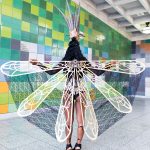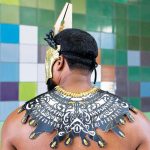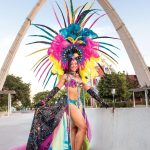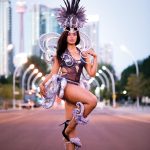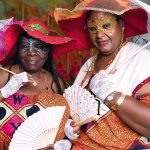Toronto Caribbean Carnival costumes
 Toronto Caribbean Carnival costumes go high tech
Toronto Caribbean Carnival costumes go high tech
BY CHRIS RATTAN From NOW Toronto
As carnival culture spreads globally, local costume designers are using technology to rekindle interest in old traditions
Carnival masqueraders are a common sight at Dufferin station, the gateway to the Ex, around parade time. The Inkwell Project’s tech-infused designs aim to stand out from the crowd.
KING & QUEEN SHOWCASE at Lamport Stadium (1155 King W.), Thursday (Aug 2), 7 pm to 11:55 pm. $30-$200. GRAND PARADE at Exhibition Place (100 Princes’ Blvd), Saturday (Aug 4), 8:30 am to 8:30 pm. $10-$200. torontocarnival.ca
It’s less than a week until the official launch of the Toronto Caribbean Carnival at Nathan Phillips Square on July 10, and designer Candice Dixon is running on little sleep. She expects sleepless nights to be part of her lot until the first weekend in August when Carnival, its big bands, big parties and costumed paraders, descend upon the city. Nevertheless, she’s hooked.
Bit by the Carnival costume bug eight years ago, she’s been designing for the parade ever since: “It’s euphoria – to see all these people, who’ve come to know you personally, say they feel beautiful in a design you first drew on paper and that’s now come to life.”
Between now and that moment, she’ll have some 90 costumes to make, feathering, beading and bending wire into the night for the masqueraders in her section. This year she’s designing for a relatively new band on the block, Venom Carnival.
But right now, in a small workspace at Ryerson University’s Design Fabrication Zone she’s focused on just five costumes for the Inkwell Project, a partnership between DFZ and her own SugaCayne Designs in association with Venom. She believes these pieces will be showstoppers, and, as she pores over the last minute details with her team, two 3D printers construct headpieces layer by meticulous layer, confirming with their constant hum that Dixon will be serving looks the parade hasn’t seen before.
Carnival costume design is built on traditional craftsmanship. In mas camps, which are warehouse-size design studios, designers ply a trade rooted in techniques and cultural traditions reaching back toward slavery (see sidebar). In Toronto, some of those designers, reverently called elders, have been creating costumes since carnival was first given as a gift to Canada from Dr. Eric Williams, Prime Minister of Trinidad and Tobago, to celebrate the centennial in 1967.
Candice, alongside her husband and SugaCayne Designs’ business manager Dwayne Dixon, have a vision to preserve those traditions while bringing technological innovation to carnival costume design. They have large ambitions for the Inkwell Project as they aim to distinguish Toronto in a global and, thanks to Instagram, increasingly visible pool of carnivals, attract a younger but flagging generation of designers and unlock new revenue streams for costume producers.
“I want to see [Toronto carnival] become a bigger industry, because it’s ours,” says Candice. “And our community could live off of it if we really wanted to.”
DO DESIGNERS DREAM IN 3D?
Mas camps in the GTA are primarily situated in Scarborough, which makes SugaCayne’s workspace at the DFZ at Church and Gould an anomaly, both in terms of location and the technology housed within it.
Despite the time crunch, a spirit of R&D pervades the air on a Wednesday night in the workspace. A few nights ago, Candice dreamt that ink had exploded onto one of her creations – a costume based on the four colours of CMYK printers. The dream sparked an idea, which she brought to the team: can we recreate the dynamic movement of an explosion of ink in 3D? When you have two DFZ technicians (Lily Jeon and Naveed Khan), a 3D and AR (augmented reality) design specialist (Quentin VerCetty), a student architect (Alyssa Carere) and a student fashion designer (Zehna Odwar), on your team, the answer is yes.
Sometime after thanking her team for “believing in my crazy,” Candice puts the magenta ink-splat in my hand. It was laser-cut with acrylic and thermal-formed until it achieved the shape from her dream.
Around the workspace are materials and concepts that wouldn’t normally be found in carnival costume design. A laser cutter is carving out an intricate calligraphy pattern from a lightweight panel of Baltic birch; the design for a chest-piece by VerCetty, which is based on Ge’ez, an ancient Ethiopian script, is projected on the wall, later to be laser-cut; and squid tentacles are covered with a durable material called Worbla, which is popular in cosplay costume design. Carere has been in the cosplay scene for seven years and introduced the lightweight and durable material to the project. It’s one of the strangest additions to a carnival piece, an element Candice hopes “will make people squeal, ‘what is that?’”
Before embarking on this adventure, she had looked to the envelope-pushing, sculptural designs of Iris Van Herpen, the subject of a retrospective on now at the Royal Ontario Museum. When I ask her about the ways technology has stretched her as a designer, she says, “The sky’s the limit on what can be realized.”
INSTAGRAM IS A CRYSTAL BALL
Technology isn’t just shaping the costumes, it’s fuelling carnival’s popularity through social media. Brooklyn, Miami and the Jamaican centres of Kingston, Ocho Rios and Montego Bay all have celebrations that, like Toronto’s, are directly influenced by Trinidad. Not to mention myriad other carnivals crossing the globe.
With “the crystal ball that is Instagram,” a favourite saying of Dwayne Dixon, one can see exactly what’s happening at each festival and whose designs are raising the bar. When Rihanna posts photos of herself celebrating Barbados’ Crop Over festival in costumes flaunting beads, feathers and body, she’s garnering millions of likes and turning an equal number of heads.
For Dwayne, if carnival-goers can see what’s happening in other cities, and potentially make their hefty financial investment (costumes can run anywhere from $200 to $1,000+) to play mas in a seemingly more exciting place, what’s the draw that will keep Toronto’s carnival unique?
He believes that the Inkwell Project is at the forefront of innovative, attention-grabbing designs that, with time and investment, could make Toronto stand out (on Instagram and otherwise).
They drew in a group of Black summer camp kids headed to the train at Dufferin station, where two of the models were shot for this feature. Clad in yellow T-shirts, the kids stopped to excitedly ask: “Are you from Wakanda?” referencing the fictional African country at the centre of the 2018 afrofuturist film Black Panther.
“When our models walk in these costumes, it’s a magnet for attention,” says Dwayne Dixon. “They were designed with innovation in mind and look different from what’s out there. We’re rooted in traditional mas, but we’re looking at it from the future.”
Carnival is a huge money generator for the city. According to Artscape’s 2015 Canadian Arts, Culture and Creative Sector report, Toronto Caribbean Carnival’s total economic impact in 2009 was $438 million.
Yet little of that money trickles down to costume producers. Material costs might be recouped through sales, but it’s largely a volunteer-driven gig. To produce the large orders for Venom, Candice relies on her network of family and friends who are willing to stay up with her until the routine 3 or 4 am finish times. This is on top of her full-time job in the buying office of a major retailer.
By contrast, carnival in Trinidad is a full-fledged industry. In 2016, Candice received a grant from the Ontario Arts Council to travel to the island, where she was mentored by Douglas John, one of the top costume designers. There she saw carnival integrated within the fabric of society: banks lent out carnival loans, post-secondary schools had carnival arts streams and KFC offered meal deals called Road March Specials. Designers could make a living, finding work and support throughout the calendar year.
The Dixons position Inkwell as the kind of tent-pole project with the potential to generate similar investment from granting bodies and larger institutions.
It filled a need for Ryerson. The university was searching for ways to foster collaboration between two of its incubators, the Fashion Zone and the Design Fabrication Zone, which are slated to move into the same building.
Last year, the school sponsored a Hackathon inviting students to come up with designs that integrated technology with carnival design concepts. The event attracted some 20 robotics students, engineers, architects and fashion designers. In subsequent weeks, the DFZ and SugaCayne partnership realized its first iteration: the Chrysalis Project.
“The concepts they came up with are things I wouldn’t have thought of in a zillion years,” says Candice. “It’s because they all came from different backgrounds. It was mind-blowing.”
TECHNOLOGY MEETS TRADITION
Over the years, veteran costume designer Clarence Forde has seen Toronto carnival move toward “bikini mas,” which he calls, “a set of half-nakedness with feathers” that bears little relation to the themes chosen by leaders to represent their bands every year and which designers are meant to faithfully and creatively execute.
Young designers and masqueraders have told him that bikini mas allows them to “free up themselves,” to revel without the restrictions of clothing. But Forde argues that there’s a sparseness to both materials and ideas in bikini mas that don’t communicate the themes with clarity or depth. He believes the younger generation doesn’t understand the history or meaning behind carnival costumes, which may explain why they aren’t taking up the traditional craft.
The Inkwell Project isn’t out to replace bikini mas, but it is another way to move carnival design forward from a technology perspective without leaving tradition behind.
Peering into Dwayne’s Instagram crystal ball, it’s clear that young people’s interest in carnival is there in terms of posts, likes and reach. But when speaking to a generation that communicates over tech, he understands that you must engage them with tech, otherwise you’ll lose their interest.
Carere, a third-year architecture student who grew up in Ancaster and had no exposure to carnival in those days, was drawn by the idea of working with digital tools. “I got involved in 3D tech although I’m not super knowledgeable,” she says. “But I can now take the aspects I learned into my architecture program.”
The partnership with Ryerson means access to “students who maybe felt apprehensive or didn’t know if Caribana spoke to them,” says Dwayne. He believes tech provides an entryway for young people from various backgrounds. While he has his eye on piquing the interest of the young generation, he also asks: “How do we innovate while also respecting the traditions, so we’re not alienating the elders?”
Creatively, the Inkwell designs are enhanced by tech. Laser-cutting allows Candice a level of precision she’d never be able to achieve by hand. “The detail you can get is unmatched,” she says. “Those sharp edges and lines are what people are drawn to when they see these pieces.”
But advances in tech mean little if not rooted in carnival’s rich traditions.
Inkwell’s designs keep the handcrafted elements like wire-bending and feathering. Concepts also make direct allusions to traditional characters, such as the Dame Lorraine, a mockery of the 19th-century aristocratic class, which influenced the Victorian bodice and long skirt of the CMYK costume.
That respect for tradition comes from a deep history, connected back to Africa, that provides a foundation for each costume.
Designing around the theme “inked,” Candice based her concepts on indigo, a natural dye, and what it has meant to the history of African peoples and their migration.
She researched the history of African dye pits, which supported ancient, handmade industries still struggling to survive today; the rise of indigo plantations in Haiti and Jamaica, which coincided with the cotton boom built on Black slave labour; and the role of calligraphy across Africa, China and the Islamic world.
For a costume centred on that early form of writing, Candice brought in artist Tiffany Joy Villahermosa to create a design that would speak to the roots of carnival. On a pair of movable, birchbark wings, the word “freedom” is delicately etched while “independence” and “emancipation” were sewn into the corset by Odwar in the same style.
“I knew that when people asked about this piece, I wanted to be able to bring up the reasons why we celebrate our culture through this thing called carnival,” says Candice. “I wanted the costume to be a statement piece.”
IMAGES: Photos by Samuel Engelking
WEB_Caribbean Carnival_3320.jpg
Caribbean-Carnival_9121.jpg
The long skirt of the CMYK costume is an allusion to the Dame Lorraine, a traditional mas character.
Print_3578-print.jpg
The word “freedom” is etched into the Baltic birch wings of the calligraphy costume.
WEB_Dame Lorraine_2870.jpg
Dame Lorraine costumes by Cajuca Mas Arts.
PRINT_Caribbean-Carnival_3644-print.jpg
The calligraphy costume features a chest- and back-piece with a design inspired by an ancient Ethiopian writing system.
PRINT_Caribbean-Carnival_9261_FIX-.jpg
Tentacles covered in Worbla, a material popularly used in cosplay, make for an eccentric addition to the squid costume.
For more on this story go to: https://nowtoronto.com/culture/toronto-caribbean-carnival-costume-design/

